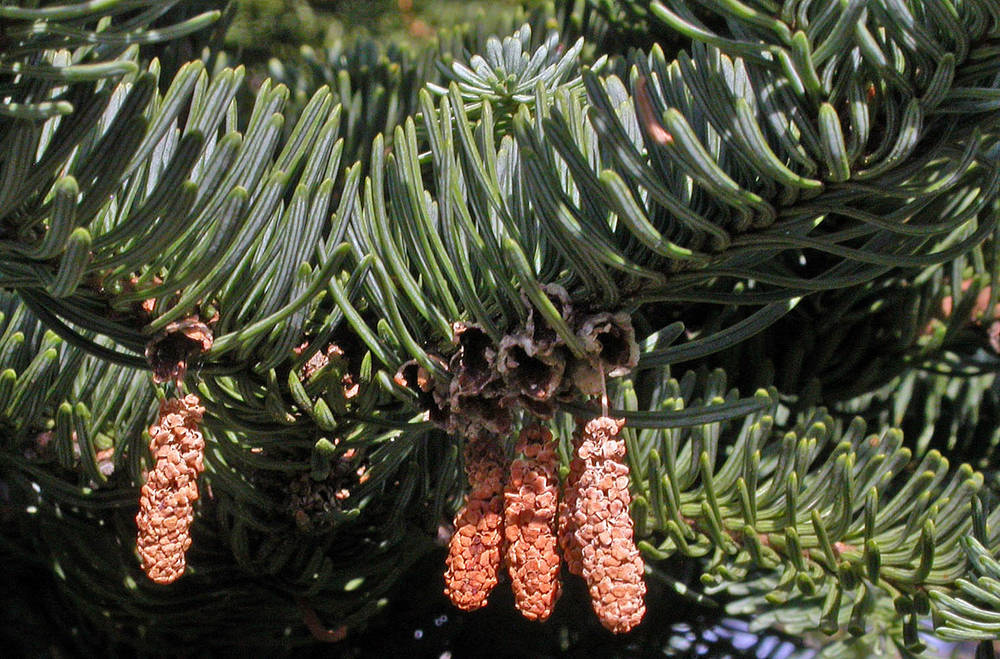Abies procera
Abies concolor x Abies grandis
(synonym of Abies lowiana)
noble fir
California white fir, Sierra white fir
1-ranked, curving upward; flexible to sti?, 1–3.5 cm × 1.5–2 mm;
cross section 4-angled, occasionally weakly 4-angled;
abaxial surface bluish green, glaucous, with 2–4 whitish bands, 12–28 stomatal rows;
adaxial surface bluish green, glaucous, often with 2 whitish bands, 0–14 stomatal rows;
apex rounded to notched.
2-ranked or if 1-ranked only on upper branches, spreading to erect and curving upward; flexible;
cross section flat, 1.5–6 cm × 1.5–3 mm;
abaxial surface grayish to bluish green, often with white glaucous bands, 4–7 stomatal rows on each side of midrib;
adaxial surface grayish to bluish green, grooved, with 0–12 stomatal rows;
apex generally rounded, rarely notched on lower branches.
reddish.
red, purple, yellow or green.
11–13 × 2–4 mm, tan to brown;
wings slightly longer than body.
7–12 × 3 mm, tan;
wings 1.5–2 times long as body.
to 2.5 m in diameter;
bark gray; smooth when young, furrowed and reddish brown with age;
branches at right angles to trunk;
twigs opposite to whorled, pubescent for several years.
to 1.5 m in diameter;
bark white to gray; smooth, furrowed;
branches spreading, drooping;
twigs generally opposite, glabrous or with yellow to brown pubescence.
oblong-cylindrical, 10–15 cm long, purple to green;
scales pubescent;
bracts exserted and reflexed over scales, covering over 90% of cone at maturity.
cylindrical, 6–12 cm long, usually green, rarely purple;
scales pubescent;
bracts included; shorter than the scales.
=24.
Abies procera
Abies concolor x Abies grandis
Mid-elevation to subalpine forests. 300–2000 m. Casc, CR. CA, WA. Native.
Morphological and DNA evidence indicates that no pure Abies magnifica is likely to exist in Oregon. As a result, all previously described populations of A. magnifica are now assigned to A. magnifica × A. procera. Specimens of A. magnifica × A. procera can be distinguished from pure A. procera by seed cone and seed cone bract morphology.
Mid-elevation forests. 900–2500 m. BR, BW, Casc, ECas, Sisk, WV. CA. Native.
DNA evidence indicates that pure Abies concolor may not exist in Oregon. Rather, all previously known populations of A. concolor are now assigned as A. concolor × A. grandis. These populations vary in their degree of morphological intermediacy between A. concolor and A. grandis. However, specimens of A. concolor × A. grandis can be distinguished from pure A. grandis by leaf morphology and the seed cone scales.
Stephen Meyers
Stephen Meyers
- Local floras:
CA,
OR,
WA
- Local Web sites:
CalFlora,
CalPhotos,
Flora NW,
PNW Herbaria
WildflowerSearch
iNaturalist (observations)
USDA Plants Database
- LBJ Wildflower Center
- SEINet
- Plants of the World Online
- Encyclopedia of Life
- Wikipedia
- Google Image Search




